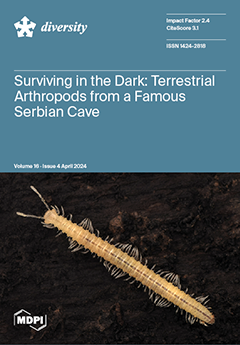This study aims to investigate the impact of diverse forest stand types and soil depths on soil ecological stoichiometry characteristics, shedding light on nutrient limitations and cycling patterns within the mid-subtropical forest ecosystem in southwest China during spring. The research focused on four representative forest stands situated in Fanjing Mountain:
Castanopsis fargesii (
C. fargesii),
Cyclobalanopsis multiervis (
C. multiervis),
Cyclobalanopsis argyrotricha (
C. argyrotricha), and
Rhododendron argyrophyllum Franch (
R. argyrophyllum). Sample plots were established in these forest types, and soil samples were collected from the 0–20 cm and 20–40 cm soil layers in March, spring of 2023. Various soil parameters, including pH, soil organic carbon (SOC), total nitrogen (TN), total phosphorus (TP), soil microbial biomass carbon (MBC), soil microbial nitrogen (MBN), and soil microbial phosphorus (MBP) were measured, and their stoichiometric ratios were calculated. The findings of the study were as follows: (1) In the 0–20 cm soil layer,
C. argyrotricha exhibited the highest soil organic carbon, followed by
C. fargesii,
C. multiervis, and
R. argyrophyllum with the lowest content. No significant differences in soil organic carbon were observed among the four forests in the 20–40 cm soil layer. Additionally,
C. argyrotricha displayed a significantly higher soil C:N ratio compared to other forest types in different soil layers. In the typical broad-leaved forest area of Fanjing Mountain, the TP was classified as deficient. (2) In the 0–20 cm soil layer, the MBC of
C. fargesii surpassed
C. multiervis,
C. argyrotricha, and
R. argyrophyllum by 26.59%, 42.92%, and 24.67%, respectively. There were no significant differences in soil MBC:MBP ratio and MBN:MBP ratio, regardless of forest species and soil depths. The low availability of soil nitrogen in different forest stand types in Fanjing Mountain strongly limits soil microorganism biomass. (3) The correlation between SOC, TN, TP, and their stoichiometric ratios varied across different soil layers. Therefore, in managing the Fanjing Mountain forest area, attention should be paid to supplementing N and P in the soil.
Full article





